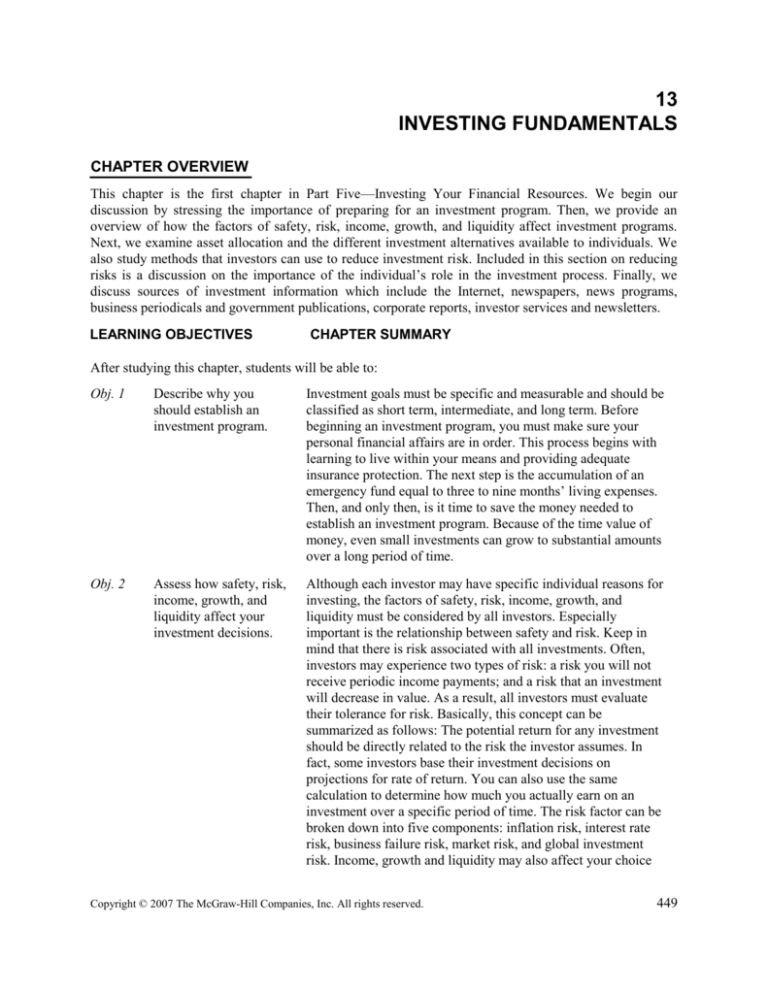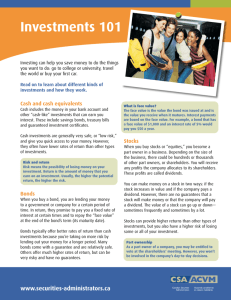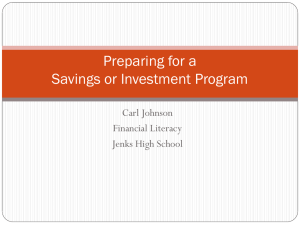
13
INVESTING FUNDAMENTALS
CHAPTER OVERVIEW
This chapter is the first chapter in Part Five—Investing Your Financial Resources. We begin our
discussion by stressing the importance of preparing for an investment program. Then, we provide an
overview of how the factors of safety, risk, income, growth, and liquidity affect investment programs.
Next, we examine asset allocation and the different investment alternatives available to individuals. We
also study methods that investors can use to reduce investment risk. Included in this section on reducing
risks is a discussion on the importance of the individual’s role in the investment process. Finally, we
discuss sources of investment information which include the Internet, newspapers, news programs,
business periodicals and government publications, corporate reports, investor services and newsletters.
LEARNING OBJECTIVES
CHAPTER SUMMARY
After studying this chapter, students will be able to:
Obj. 1
Describe why you
should establish an
investment program.
Investment goals must be specific and measurable and should be
classified as short term, intermediate, and long term. Before
beginning an investment program, you must make sure your
personal financial affairs are in order. This process begins with
learning to live within your means and providing adequate
insurance protection. The next step is the accumulation of an
emergency fund equal to three to nine months’ living expenses.
Then, and only then, is it time to save the money needed to
establish an investment program. Because of the time value of
money, even small investments can grow to substantial amounts
over a long period of time.
Obj. 2
Assess how safety, risk,
income, growth, and
liquidity affect your
investment decisions.
Although each investor may have specific individual reasons for
investing, the factors of safety, risk, income, growth, and
liquidity must be considered by all investors. Especially
important is the relationship between safety and risk. Keep in
mind that there is risk associated with all investments. Often,
investors may experience two types of risk: a risk you will not
receive periodic income payments; and a risk that an investment
will decrease in value. As a result, all investors must evaluate
their tolerance for risk. Basically, this concept can be
summarized as follows: The potential return for any investment
should be directly related to the risk the investor assumes. In
fact, some investors base their investment decisions on
projections for rate of return. You can also use the same
calculation to determine how much you actually earn on an
investment over a specific period of time. The risk factor can be
broken down into five components: inflation risk, interest rate
risk, business failure risk, market risk, and global investment
risk. Income, growth and liquidity may also affect your choice
Copyright © 2007 The McGraw-Hill Companies, Inc. All rights reserved.
449
of investments.
LEARNING OBJECTIVES
CHAPTER SUMMARY
Obj. 3
Explain how asset
allocation and different
investment alternatives
affect your investment
plan.
Asset allocation is the process of spreading your assets among
several different types of investments (sometimes referred to as
asset classes) to lessen risk. Typical asset classes include largecap stocks, mid-cap stocks, small-cap stocks, foreign stocks,
bonds, and cash. The percentage of your investments that
should be invested in each asset class is determined by your
age, investment objectives, your ability to tolerate risk, how
much you can save and invest each year, the dollar value of
your current investments, and the economic outlook for the
economy. Typical long-term investment alternatives include
stocks, bonds, mutual funds, and real estate. More speculative
investment alternatives include options, commodities, precious
metals, gemstones, and collectibles. Before choosing a specific
investment, all potential investments should be evaluated on the
basis of safety, risk, income, growth, and liquidity. With all of
these factors in mind, the next step is to develop a specific,
personal investment plan.
Obj. 4
Recognize the
importance of your role
in a personal investment
program.
It is your responsibility to monitor the value of your
investments. Accurate recordkeeping can also help you spot
opportunities to maximize profits or reduce losses when you sell
your investment. These same detailed records can help you
decide whether you want to invest additional funds in a
particular investment. To achieve their financial goals, many
people seek professional help. In many cases, they turn to
stockbrokers, lawyers, accountants, bankers, insurance agents,
or financial planners. Finally, it is your responsibility to
determine how taxes affect your investments.
Obj. 5
Use the various sources
of financial information
that can reduce
investment risks and
increase investment
return.
Since there is more information on investments than most
investors can read and comprehend, investors must be selective
in the type of information that they use for evaluation purposes.
Sources of information include: the Internet, newspapers and
news programs, business periodicals, government publications,
corporate reports, and investor services.
450
Copyright © 2007 The McGraw-Hill Companies, Inc. All rights reserved.
INTRODUCTORY ACTIVITIES
Point out the learning objectives (p. 406) in an effort to highlight key points in the chapter.
Discuss the information presented in the opening case (p. 407). Ask students to comment on Clare
and Noah Cardoza’s financial planning activities.
Ask students to share experiences about investments they or their family have had.
Point out the benefits of investing for long-term personal financial security.
CHAPTER 13 OUTLINE
I.
Preparing for an Investment Program
A. Establishing Investment Goals
B. Performing a Financial Checkup
1. Work to Balance Your Budget
2. Obtain Adequate Insurance Protection
3. Start an Emergency Fund
4. Have Access to Other Sources of Cash for Emergency Needs
C. Getting the Money Needed to Start an Investment Program
1. Priority of Investment Goals
D. The Value of Long-Term Investment Programs
II.
Factors Affecting the Choice of Investments
A. Safety and Risk
B. The Risk-Return Tradeoff
1. Evaluating Your Tolerance for Risk
2. Calculating Return on Investment
C. Components of the Risk Factor
1. Inflation Risk
2. Interest Rate Risk
3. Business Failure Risk
4. Market Risk
5. Global Investment Risk
D. Investment Income
E. Investment Growth
F. Investment Liquidity
III.
Asset Allocation and Investment Alternatives
A. Asset Allocation and Diversification
1. The Time Factor
2. Your Age
B. An Overview of Investment Alternatives
Copyright © 2007 The McGraw-Hill Companies, Inc. All rights reserved.
451
C. Stock or Equity Financing
D. Corporate and Government Bonds
E. Mutual Funds
F. Real Estate
G. Other Investment Alternatives
H. A Personal Investment Plan
IV.
Factors That Reduce Investment Risk
A. Your Role in the Investment Process
1. Monitor the Value of Your Investment
2. Keep Accurate and Current Records
B. Other Factors that Improve Investment Decisions
V.
Sources of Investment Information
A. The Internet
B. Newspapers and News Programs
C. Business Periodicals and Government Publications
D. Corporate Reports
E. Investor Services and Newsletters
452
Copyright © 2007 The McGraw-Hill Companies, Inc. All rights reserved.
CHAPTER 13 LECTURE OUTLINE
I. PREPARING FOR AN INVESTMENT PROGRAM (p. 408)
The decision to start an investment program is an important first step to accomplishing
your long-term financial goals.
Establishing Investment Goals (p. 408)
To be useful, investment goals must be specific and measurable.
Investment goals must be tailored to your particular financial needs.
Investment goals must always be oriented toward the future.
Performing a Financial Checkup (p. 409)
Before beginning an investment program, you must make sure your personal financial
affairs are in order. To be successful, you must:
1. Work to balance your budget.
2. Obtain adequate insurance protection.
3. Start an emergency fund equal to three to nine months’ living expenses.
4. Have access to other sources of cash for emergency needs.
Getting the Money Needed to Start an Investment Program (p. 410)
Once you have established your investment goals and completed your personal financial
checkup, it’s time to start investing—assuming that you have enough money to finance
your investments.
As pointed out earlier in this chapter, no one can make you save money to finance your
investment program.
You may be the most important part of a successful investment program.
1. What is important to you?
2. What do you value?
The Value of Long-Term Investment Programs
(p. 410)
There is no better time to begin an investment program than when you are young.
The reason is simple: If you start an investment program when you are young, let the
time value of money work for you, and make sound investments, you won’t have to
worry about finances when you reach retirement age.
Many individuals never start an investment program because they only have a small sum
of money. But even small sums of money grow over a long period of time.
Exhibit 13-1 shows how much your investment would be worth at the end of selected
time periods with different rates of return if you invested $2,000 each year.
Copyright © 2007 The McGraw-Hill Companies, Inc. All rights reserved.
453
CHAPTER 13 LECTURE OUTLINE
II. FACTORS AFFECTING THE CHOICE OF INVESTMENTS (p. 412)
Although each investor may have specific individual reasons for investing, there are a
number of factors that all investors must consider.
Safety and Risk (p. 412)
The safety and risk factors are two sides of the same coin. Safety in an investment means
minimal risk of loss. On the other hand, risk in an investment means a measure of
uncertainty about the income.
Investments range from very safe to very risky. At one end of the investment spectrum
are very safe investments that attract conservative investors. Investors pick such
investments because they know there is very little chance that investments will become
worthless.
At the other end of the investment spectrum are very risky investments. A speculative
investment is high-risk investment that is made in the hope of earning a relative large
profit in a short time. Such investments offer the possibility of a larger dollar return, but
if they are unsuccessful, the investor may lose most or all of the initial investment.
The Risk-Return Tradeoff (p. 413)
454
You may experience two types of risks with most investments.
1. Investors often choose some investments because they provide a predictable source
of income. In reality, there is a risk that you will not receive periodic income
payments.
2. A second type of risk with many investments is that an investment will decrease in
value.
Evaluating your tolerance for risk. When investing, not everyone has the same tolerance
for risk. In fact, some people may actually be risk averse.
1. Typically, a risk averse investor will seek investment alternatives that offer the least
risk.
2. When people choose investments that have a higher degree of risk, they expect
larger returns.
3. One basic rule sums up the relationship between the factors of safety and risk: The
potential return on any investment should be directly related to the risk the investor
assumes.
Calculating return on investment. The rate of return you receive is often determined
by the amount of risk you are willing to take.
1. Some investors often base their investment decisions on projections for rate of
return.
2. You can also use the same calculation to determine how much you actually earn on
an investment over a specific period of time.
3. To calculate rate of return, the total income you receive on an investment over a
specific period of time is divided by the original investment amount.
4. With this information, it is possible to compare the rate of return for different
investment alternatives that offer more or less risk.
Copyright © 2007 The McGraw-Hill Companies, Inc. All rights reserved.
CHAPTER 13 LECTURE OUTLINE
Components of the Risk Factor (p. 416)
The factor of risk associated with a specific investment does change from time to time. In
fact, the overall risk factor can be broken down into the following five components.
1. Inflation risk
2. Interest rate risk
3. Business failure risk
4. Market risk
5. Global Investment Risk
Investment Income (p. 418)
Investors sometimes purchase certain investments because they want a predictable source
of income from their investment. The safest investments are passbook savings accounts,
certificates of deposit, and securities issued by the U.S. government.
If income is a primary objective, most investors choose municipal bonds, corporate
bonds, preferred stock, utility stocks, or selected common stocks. Other investments that
provide income potential are mutual funds and real estate rental property.
When purchasing investments for income, you should be concerned about the issuer’s
ability to make periodic income or dividend payments and eventual repayment.
The more speculative investments, such as commodities, options, precious metals,
gemstones, and collectibles, offer little, if any potential for regular income.
Investment Growth (p. 418)
To investors, growth means that their investment will increase in value.
Government bonds, corporate bonds, stocks, mutual funds, and real estate may offer
growth possibilities.
Precious metals, gemstones, and collectibles are more speculative investments and offer
less predictable growth possibilities.
Investment Liquidity (p. 419)
Liquidity is the ease with which an asset can be converted to cash without a substantial
loss in dollar value.
III. ASSET ALLOCATION AND INVESTMENT ALTERNATIVES (p. 419)
By now, you are probably thinking, how can I choose the right investment for me? To
help answer that question, consider the following:
1. Since 1900, stocks have return approximately 10 percent a year and outperformed
other investment alternatives on average.
2. By comparison, government treasury bills and government bonds have return about
4 percent during the same period.
3. And projections by well-respected Roger Ibbotson, chairman of Ibbotson
Associates, the investment consulting, software, and research firm, indicate that
these same investments will perform at about the same pace between now and the
year 2025.
4. In reality, stocks have a place in every investment portfolio, but there is more to
Copyright © 2007 The McGraw-Hill Companies, Inc. All rights reserved.
455
CHAPTER 13 LECTURE OUTLINE
establishing a long-term investment program than just picking a bunch of stocks.
Asset Allocation and Diversification. (p. 419) Asset allocation is the process of
spreading your assets among several different types of investments (sometimes referred
to as asset classes).
1. Simply put, asset allocation really means that you need to diversify and avoid the
pitfall of putting all your eggs in one basket—a common mistake made by investors.
2. Typical asset classes include stocks issued by large corporations (large cap), stocks
issued by medium size corporations (mid cap), stocks issued by small, rapidly
growing companies (small cap), foreign stocks, bonds, and cash.
3. Many financial experts argue that asset allocation is the most important factor when
establishing a long-term investment program because choosing the “right mix” of
assets will outperform the investment selections that individual investors make over
a long period of time.
4. The percentage of your investment that should be invested in each asset class is
determined by your age, investment objectives, your ability to tolerate risk, how
much you can save and invest each year, the dollar value of your current
investments, the economic outlook for the economy, and several other factors.
The Time Factor. The amount of time your investments have to work for you is an
important factor when managing your investment portfolio.
1. If you can leave your investments alone and let them work for 5 to 10 years or more,
then you can invest in stocks and mutual funds.
2. On the other hand, if you need your investment money in two years, you should
probably invest in short-term government bonds, highly rated corporate bonds, or
certificates of deposit.
Your Age. A final factor to consider when choosing an investment is your age.
1. Younger investors tend to invest a large percentage of their assets in growth-oriented
investments.
2. Older investors tend to be more conservative.
3. Financial expert, Suze Orman, suggests that you subtract your age from the number
110. The different is the percentage of your assets that should be invested in growth
investments.
4. Instead of using the number 110, some conservative financial planners suggest you
begin with the number 100.
An Overview of Investment Alternatives (p. 421)
Once you have considered the risks involved, asset allocation, the time factor your
investments can work for you, and your age, its time to consider which investment
alternative is right for you.
Stock or Equity Financing (p. 421)
456
Equity capital is money that a business obtains from its owners.
Investors should consider at least two factors before investing in stock. First, a
corporation is not obligated to repay the money obtained from the sale of stock or to
Copyright © 2007 The McGraw-Hill Companies, Inc. All rights reserved.
CHAPTER 13 LECTURE OUTLINE
repurchase the stock at a later date. Second, a corporation is under no legal obligation to
pay dividends.
There are two types of stock—common stock and preferred stock.
Corporate and Government Bonds (p. 423)
There are two types of bonds that an investor should consider. A corporate bond is a
corporation’s written pledge that it will repay a specified amount of money with interest.
A government bond is the written pledge of a government or a municipality to repay a
specified sum of money with interest.
The maturity dates for most bonds range between 1 and 30 years.
The value of a bond is closely tied to the ability of the corporation or government entity
to repay the bond at maturity and pay interest payments until maturity.
Interest payments on bonds are made every six months.
Mutual Funds (p. 423)
A mutual fund is an investment alternative available to individuals who pool their
money to buy stocks, bonds, and other securities based on the selections of professional
managers who work for an investment company.
Professional management is an especially important factor. Another reason why
investors choose mutual funds is because of diversification.
The goals of one investor may differ from those of another investor. The managers of
mutual funds realize this and tailor programs to meet individual needs and objectives.
There are at least two specific problems for mutual fund investors.
1. First, almost all investment companies allow you to reinvest income you receive
from a mutual fund during a tax year. Even though you didn’t receive cash because
you chose to reinvest the income, it is still taxable.
2. Second, mutual funds buy and sell securities within the fund’s portfolio on a regular
basis during any tax year. At the end of the year, profits that result from the mutual
fund’s buying and selling activities are paid to shareholders and are taxable. Unlike
investments you manage, you have no control over when the mutual fund sells
securities and when you will be taxed.
3. To postpone taxation of income and profits from mutual fund investments, you may
want to consider purchasing mutual fund shares that are part of an individual
retirement account or retirement plan sponsored by your employer.
Real Estate (p. 423)
As a rule, real estate increases in value and eventually sells for a profit, but there are no
guarantees.
Any investment has its disadvantages, and real estate is no exception. Like any other
investment, real estate must be evaluated.
Other Investment Alternatives (p. 424)
Speculative investments include: options, commodities, precious metals, gemstones,
coins, stamps, and antiques and collectibles. More detailed information is provided in
later chapters.
Copyright © 2007 The McGraw-Hill Companies, Inc. All rights reserved.
457
CHAPTER 13 LECTURE OUTLINE
A Personal Investment Plan (p. 424)
Earlier in this chapter we examined how the factors of safety, risk, income, growth, and
liquidity affect investments. Now it is possible to compare the different investment
alternatives to those factors. (See Exhibit 13-4.)
To be successful, you must develop a plan and then implement it.
The individual begins investment planning by establishing realistic goals.
The steps required for an effective personal plan of action are presented in Exhibit 13-5.
IV. FACTORS THAT REDUCE INVESTMENT RISK (p. 426)
Your Role in the Investment Process (p. 426)
Evaluation of an investment should begin before purchasing an investment and after it is
purchased.
Good investors continually assess the value of their investments. Some basic elements of
evaluation include:
1. Evaluate potential investments.
2. Monitor the value of your investment.
3. Keep accurate and current records.
Other Factors to Consider. To achieve their financial goals, many people seek
professional help.
1. Often investors turn to stockbrokers, lawyers, accountants, bankers, or insurance
agents. However, these professionals are specialists in one field and may not be
qualified to develop a thorough financial plan.
2. Another source of help is a financial planner who has had training in securities,
insurance, taxes, real estate, and estate planning.
3. You must also consider the tax consequences of selling your investments.
V. SOURCES OF INVESTMENT INFORMATION
(p. 428)
458
With most investments, there is more information than an investor can read and
comprehend. Therefore, an investor must be selective in the type of information that he
or she uses for evaluation purposes. The following sources may be of value:
1. The Internet
2. Newspapers and news programs
3. Business periodicals and government publications
4. Corporate reports
5. Investor services and newsletters
Copyright © 2007 The McGraw-Hill Companies, Inc. All rights reserved.








